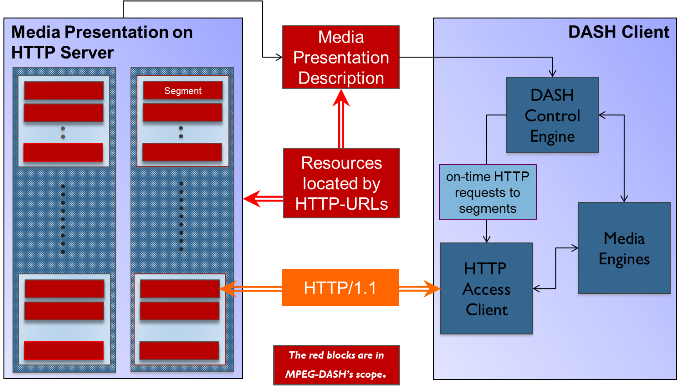Adaptive Broadcast Technologies
In the previous article I superficially reviewed the general principles of adaptive broadcasting. In this article I will consider separately each of the presented technologies of adaptive broadcasting, and also I will tell you what problems Telebreeze faced when starting to use adaptive broadcasting.

In general, there are not so many of them, and you yourself already guess which one - of course, this is Apple HTTP Adaptive Streaming (HLS).
')
1. Apple has done its best and has been using this technology for a long time on all its devices (IOS and Mac operating systems), and is also supported by the latest Android versions and most TV set-top boxes.
HLS from Apple is one of the most common HTTP video transmission protocols, which has already proven its reliability and has passed the test of time.
Certainly not perfect in our world, but Apple, as always, is on top. You do not think I'm not a fan of Apple, I just try to judge objectively.
So, a few words about the transmission of video and audio signal: The video signal is packaged in an MPEG-2 TS container, and very common MPEG H.264 (video) and AAC (audio) codecs are used. Video is encoded with a different bitrate at the output, and as a result a playlist in the format m3u8 is obtained. To protect content from unauthorized access, the AES-128 algorithm is used, which can encrypt content transmitted over HLS.
That's how you can describe all the technology Apple HTTP Adaptive Streaming (HLS).
2. Now consider the equally popular technology of adaptive broadcasting from Microsoft - Smooth Streaming.
Smooth Streaming is a protocol that is supported by the Silverlight video player, as well as Windows and Windows Phone operating systems.
What's up with Microsoft, what Apple doesn't have, or what advantages Smooth Streaming has over HLS. Although it is possible to argue about this, since these are relatively different approaches to adaptive broadcasting, but let's all look in the projection of one direction. The biggest advantage is the more versatile and extensible manifest file format (xml). A smaller advantage is that all video segments are packaged in the most common MP4 container at the time.
The video and audio signals are first segmented, and then packaged in an MP4 container as mentioned above and distributed via HTTP through the web server and CDN. H.264 (video) and AAC (audio) codecs are used.
In general, Windows is promoting its concept very successfully, which indicates their constructive competition with Apple.
3. So we got to Adobe HTTP Dynamic Streaming (HDS), which is another version of adaptive broadcasting.
As the name implies, this technology was created by Adobe and is supported on almost any personal computer in the world.
The principle of operation is similar to other adaptive HTTP technology systems. In this regard, it is difficult to single out special advantages, one can only say that HDS supports only one DRM system - Flash Access.
4. I would also like to consider the topic of the General Adaptive Broadcasting Standard.
The big problem at the moment that the broadcaster faces is to try to support the maximum possible number of solutions on various devices of its customers and use different technologies. It is expensive and not always convenient.
And here comes the need for the widespread introduction of a single video broadcasting standard. MPEG-DASH (Dynamic Adaptive Streaming over HTTP), developed by MPEG-LA and ISO, which they launched last year, is intended to become such a standard.
It can be called the most universal and perfect broadcast protocol. It has the use of manifest files (xml) in Smooth Streaming, there is also support for most container formats, and integration with UltraViolet (DRM-system), which works on the principle of “Buy once, play it anywhere”. UltraViolet will provide a unified environment for encoding all devices.
No matter how versatile this technology may be, and no matter how it is promoted by global standardizing organizations, its introduction is expected in the long term.

What kind of problems can a developer face when implementing adaptive broadcasting?
One of them is the length of the video segment that is transmitted in the stream, and how many such variants of streams should be.
If you make a segment of video too short, it increases the useless expenditure of traffic. Why is this happening, but because in each segment besides the video, the so-called overhead will be contained. The result is that the more segments, the greater the overhead, and it is this useless that consumes traffic.
But there is also the other side of the coin, if the video segment is made too long, the quality of service will decrease several times, because the user will have to wait for the quality change.
There is no universal solution to the problem, since the balance in this case can be found only through trial and error.
The coding profile parameters will depend on the adaptive broadcast technology, as well as the country and region. And here the length of the segment and the number of threads must be chosen for each appropriate case.
We, Telebreeze Corporation , use HTTP Adaptive Streaming (HLS). This system has a number of positive aspects, as well as a number of problems. I will tell about all this in the following article .
So, brief results: Each presented technology has its advantages and competes with each other, which should have a positive impact on the development of such a young direction as adaptive broadcasting, because everyone knows that competition is the engine of progress.

In general, there are not so many of them, and you yourself already guess which one - of course, this is Apple HTTP Adaptive Streaming (HLS).
')
1. Apple has done its best and has been using this technology for a long time on all its devices (IOS and Mac operating systems), and is also supported by the latest Android versions and most TV set-top boxes.
HLS from Apple is one of the most common HTTP video transmission protocols, which has already proven its reliability and has passed the test of time.
Certainly not perfect in our world, but Apple, as always, is on top. You do not think I'm not a fan of Apple, I just try to judge objectively.
So, a few words about the transmission of video and audio signal: The video signal is packaged in an MPEG-2 TS container, and very common MPEG H.264 (video) and AAC (audio) codecs are used. Video is encoded with a different bitrate at the output, and as a result a playlist in the format m3u8 is obtained. To protect content from unauthorized access, the AES-128 algorithm is used, which can encrypt content transmitted over HLS.
That's how you can describe all the technology Apple HTTP Adaptive Streaming (HLS).
2. Now consider the equally popular technology of adaptive broadcasting from Microsoft - Smooth Streaming.
Smooth Streaming is a protocol that is supported by the Silverlight video player, as well as Windows and Windows Phone operating systems.
What's up with Microsoft, what Apple doesn't have, or what advantages Smooth Streaming has over HLS. Although it is possible to argue about this, since these are relatively different approaches to adaptive broadcasting, but let's all look in the projection of one direction. The biggest advantage is the more versatile and extensible manifest file format (xml). A smaller advantage is that all video segments are packaged in the most common MP4 container at the time.
The video and audio signals are first segmented, and then packaged in an MP4 container as mentioned above and distributed via HTTP through the web server and CDN. H.264 (video) and AAC (audio) codecs are used.
In general, Windows is promoting its concept very successfully, which indicates their constructive competition with Apple.
3. So we got to Adobe HTTP Dynamic Streaming (HDS), which is another version of adaptive broadcasting.
As the name implies, this technology was created by Adobe and is supported on almost any personal computer in the world.
The principle of operation is similar to other adaptive HTTP technology systems. In this regard, it is difficult to single out special advantages, one can only say that HDS supports only one DRM system - Flash Access.
4. I would also like to consider the topic of the General Adaptive Broadcasting Standard.
The big problem at the moment that the broadcaster faces is to try to support the maximum possible number of solutions on various devices of its customers and use different technologies. It is expensive and not always convenient.
And here comes the need for the widespread introduction of a single video broadcasting standard. MPEG-DASH (Dynamic Adaptive Streaming over HTTP), developed by MPEG-LA and ISO, which they launched last year, is intended to become such a standard.
It can be called the most universal and perfect broadcast protocol. It has the use of manifest files (xml) in Smooth Streaming, there is also support for most container formats, and integration with UltraViolet (DRM-system), which works on the principle of “Buy once, play it anywhere”. UltraViolet will provide a unified environment for encoding all devices.
No matter how versatile this technology may be, and no matter how it is promoted by global standardizing organizations, its introduction is expected in the long term.

What kind of problems can a developer face when implementing adaptive broadcasting?
One of them is the length of the video segment that is transmitted in the stream, and how many such variants of streams should be.
If you make a segment of video too short, it increases the useless expenditure of traffic. Why is this happening, but because in each segment besides the video, the so-called overhead will be contained. The result is that the more segments, the greater the overhead, and it is this useless that consumes traffic.
But there is also the other side of the coin, if the video segment is made too long, the quality of service will decrease several times, because the user will have to wait for the quality change.
There is no universal solution to the problem, since the balance in this case can be found only through trial and error.
The coding profile parameters will depend on the adaptive broadcast technology, as well as the country and region. And here the length of the segment and the number of threads must be chosen for each appropriate case.
We, Telebreeze Corporation , use HTTP Adaptive Streaming (HLS). This system has a number of positive aspects, as well as a number of problems. I will tell about all this in the following article .
So, brief results: Each presented technology has its advantages and competes with each other, which should have a positive impact on the development of such a young direction as adaptive broadcasting, because everyone knows that competition is the engine of progress.
Source: https://habr.com/ru/post/206610/
All Articles